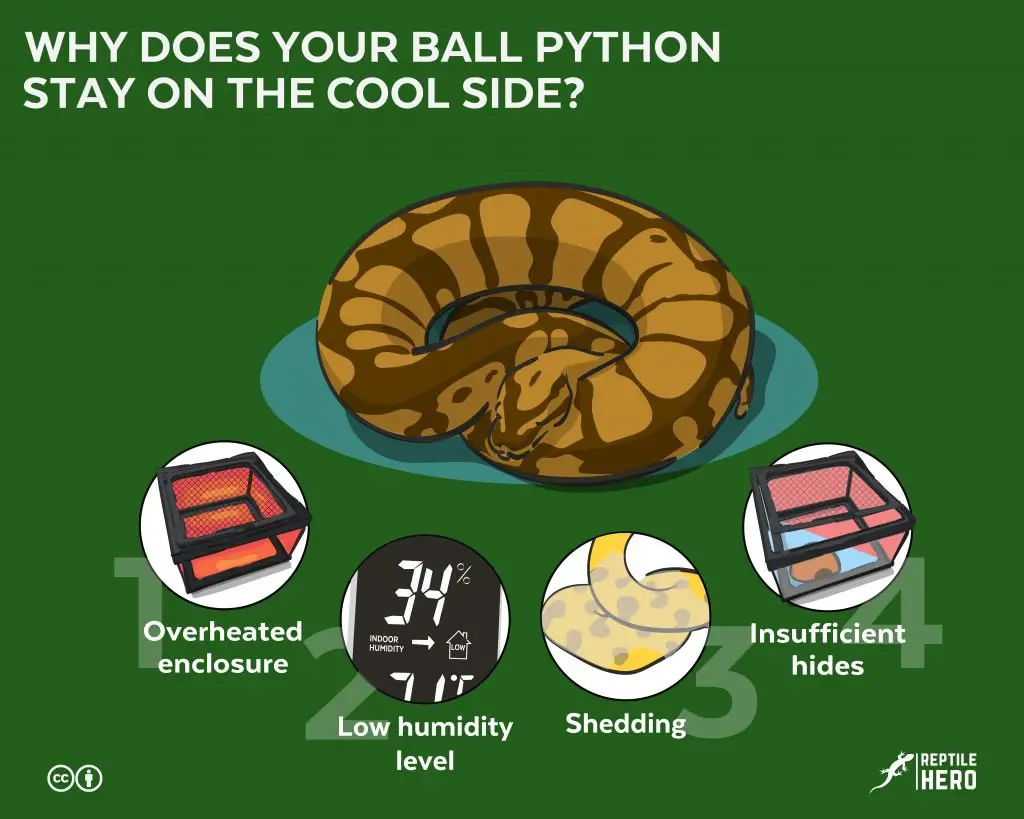Why Does Your Ball Python Stays on the Cool Side? (4 Reasons)
A ball python might stay on the cool side of the enclosure because of 1) overheated enclosure, 2) low humidity level, 3) shedding, and 4) insufficient hides. In such cases, the keeper must: always check the humidity level, air temperature, and hot spot temperature; use thermostats; replace the light bulbs with a ceramic heat emitter (CHE).

Is this your fault, or is it part of your snake’s nature?
Overheated Enclosure
One of the reasons why ball pythons choose to stay on the cool side of their enclosure is overheating. If the temperature inside the enclosure is too high, the python will prefer the cool side. Such problems might arise due to light bulbs and wrongly setting up heating equipment.
You may notice that your snake is staying either on the cool or warm side of the enclosure because it regulates its body temperature. There are two types of thermoregulation in animals. Endothermic (mammals and birds) and ectothermic. The latter includes cold-blooded animals like ball pythons. Our beloved ball pythons cannot generate heat for themselves and only rely on their surroundings to acquire or lose heat.
Fun Fact
Female ball pythons can generate heat for their egg clutch through shivering [1].
Ball pythons need to go from the warm side to the cold side of the enclosure to regulate the heat for their body. Thermoregulation may become difficult for your ball python if you use a light bulb as your snake’s heat source. A light bulb may overheat the ball python enclosure because it produces too much heat.
When you place your hand near the bulb of a lighting fixture, you may notice that it is warm. The heat produced by this bulb contributes to the overall temperature inside your ball python’s enclosure. Because of the increased temperature inside the enclosure, your ball python may stay on the cooler side of the tank to escape the heat.
What to do in this case? Keep reading. In the end, I discuss how to check and solve this problem!
Your pet’s enclosure may become too warm or too hot for your ball python if you use any heating equipment (under-tank heater, radiant heat panel, etc.) without a thermostat.

Low Humidity Level
Ball python may stay on the cool side of the enclosure because the humidity level is too low on the warm side. One of the culprits of such dryness is the light bulbs.
Aside from being too warm, your ball python may seek the cooler area of the enclosure because it is too dry on the warmer side. When using a substrate like a coco husk, it is quite easy to spot this problem. Indeed, you may notice that the warmer part’s substrate is drier than the one on the cool side.
Many keepers have been complaining about the low humidity level inside their ball python’s enclosure, and some are having a hard time maintaining it. Most of the time, lighting fixtures in the enclosure can cause such dryness problems pushing the python to the cool side. Using a light bulb as a heat source was a mistake when I was still new to ball python keeping. Depending on wattage and how far your lighting fixture is, light bulbs produce excessive heat resulting in dryness inside the enclosure.
Shedding
A ball python may stay on the cool side of its enclosure to seek more humidity for the shedding process. During shedding, ball pythons and other reptiles need a higher water content in the air as it greatly facilitates the removal of the old skin layers.
You may notice that your ball python stays on the cool side of the enclosure because it seeks more humidity to shed easily. The recommended humidity level for shedding is up to 85%. You can increase the humidity level through misting inside your ball python’s enclosure.

Insufficient Hides
A ball python might stay on the cooler side of the enclosure because it is the only location of the available hide. Staying on the cool side often happens if no hides are present on the warm side.
The ball python enclosure should have hides on both enclosure’s sides (warm and cool). Indeed, our beloved snakes prefer and feel more secure in cluttered and narrow spaces than in broad and open ones. By providing different hides on both ends of the enclosure, your ball python doesn’t have to choose between security and thermoregulation.
Ball Python Always on the Cool Side – Solutions
If a ball python stays on the cool side for a long time, the keeper must:
- Always check the humidity level, air temperature, and hot spot temperature
- Use thermostats
- Replace the light bulbs with a ceramic heat emitter (CHE)
Check humidity, air, and hot spot temperature
Suppose you notice your snake is only staying on the cool side of the enclosure. In that case, one of the things you could do is to check the humidity level, cool side air temperature, and hot spot temperature and make sure that the levels are within the recommended range constantly. Using a temperature gun like this from Amazon can make identifying the temperature easy, especially in the hot spot of your ball python’s enclosure.
The recommended parameters inside the ball python’s enclosure are 80-85°F on the cool side, 90°F in the hotspot, and a humidity level of 55-60%.
As long as you provide the recommended parameters, your ball python can choose the necessary spot for itself to thermoregulate. Ball pythons are ectotherms, and this is why we need to provide warm and cool parts inside their enclosures to help them thermoregulate.
Use Thermostats
If you notice that your ball python stays on the cooler side of its enclosure, you must check all heating equipment to see if it is correctly plugged into the thermostats. Using thermostats like is a must to prevent burns or the death of your ball python.
I heard of cases of burnt ball pythons that lead to death. One thing in common is that the owners were not using thermostats. Without a thermostat, heating equipment might overheat. Using a thermostat with any heating equipment is essential to keep the temperature within reasonable levels inside the enclosure.
The thermostat will be plugged into the primary power source and not your heating equipment. Your heating apparatus will now be plugged into the thermostat. Then, the thermostat will regulate and maintain the temperature you set for your ball python’s enclosure.
Replace the light bulbs with a ceramic heat emitter (CHE)
Light bulbs “dry out” the enclosure faster than other heating equipment. A ceramic heat emitter (CHE) like this from Amazon can provide the correct air temperature without losing too much humidity inside your ball python’s enclosure.
The recommended wattage of a ceramic heat emitter for your ball python’s enclosure is 60 watts for a 10-20 gallon enclosure; 100 watts for a 30-40 gallon enclosure. A 10-20 gallon enclosure is more than enough for your hatchling ball python to be housed in, while the 30-40 gallon enclosure is for your adult size ball python. Factors like your room temperature and ventilation may affect the heat needed from CHE. The use of a thermostat is a must.
Should You Move Your Python To The Warmer Side?
Moving a ball python that decided to stay on the cool side towards the warmer side of the enclosure is not recommended. Indeed, this underlies the presence of a problem that will only be exacerbated if the animal is forced to stay on the warmer side.
Summary of Why a Ball Python Stays in the Cool Side
- A ball python may stay on the cool side of the enclosure because of: an overheated enclosure, low humidity level, shedding, and insufficient hides.
- When a ball python stays on the cool side for a long time, the owner must: always check the humidity level, air temperature, and hot spot temperature; use thermostats together with any heating equipment; replace the light bulbs with a ceramic heat emitter (CHE).
- Forcing a ball python that decided to stay on the cool side to move to the warmer side of the enclosure is not recommended as it may cause health problems to your snake.
Sources
[1]
FABIEN AUBRET, XAVIER BONNET, RICHARD SHINE, STEPHANIE MAUMELAT, Clutch size manipulation, hatching success and offspring phenotype in the ball python (Python regius), Biological Journal of the Linnean Society, Volume 78, Issue 2, February 2003, Pages 263–272, https://doi.org/10.1046/j.1095-8312.2003.00169.x






